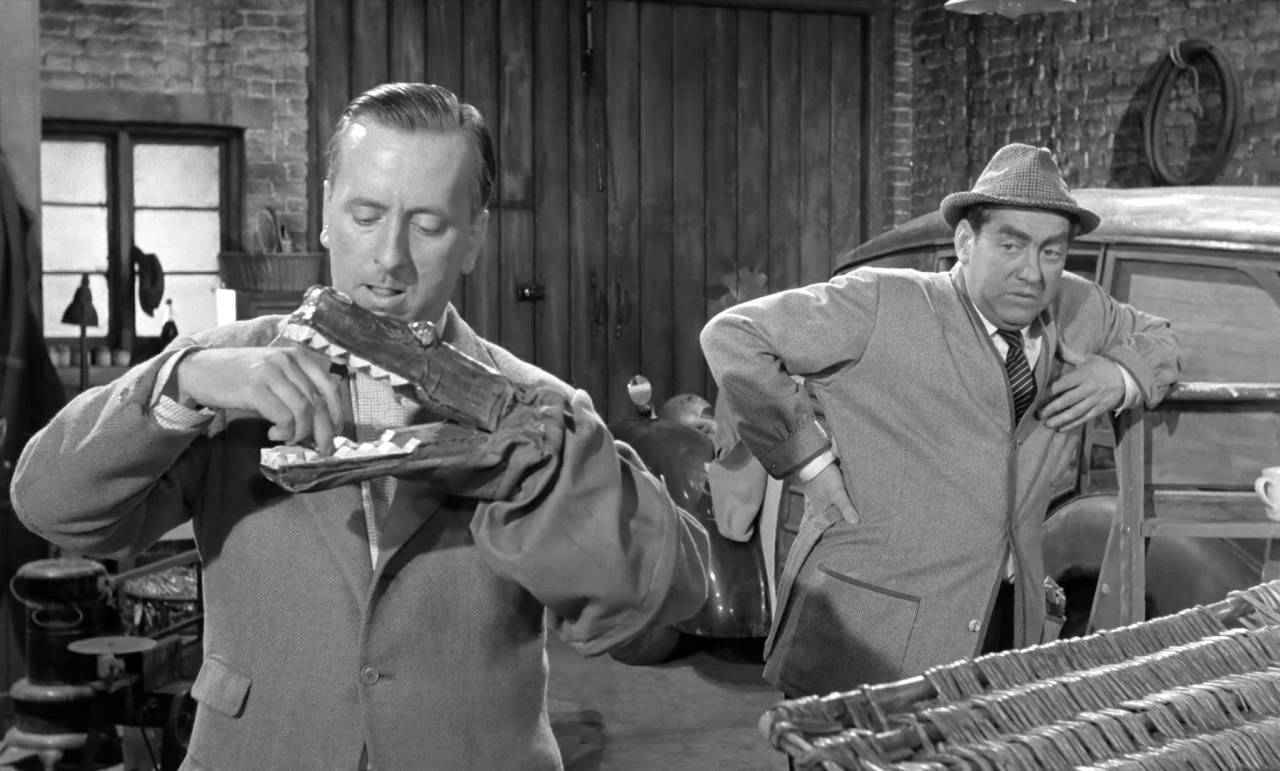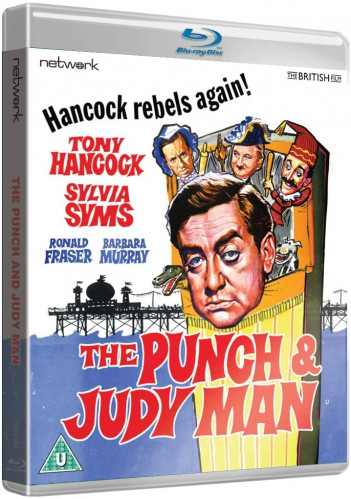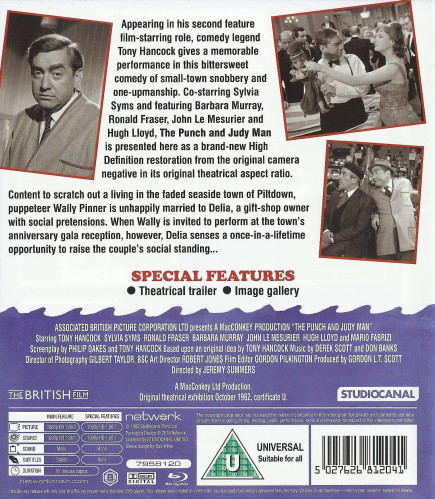TONY HANCOCK: THE PUNCH AND JUDY MAN [1963 / 2019] [Blu-ray] [UK Release]
Hancock Rebels Again!
Appearing in his second feature film starring role, comedy legend Tony Hancock gives a memorable performance in this bittersweet comedy of small-town snobbery and one-upmanship. Co-starring Sylvia Syms and featuring Barbara Murray, Ronald Fraser, John Le Mesurier and Hugh Lloyd. ‘THE PUNCH AND JUDY MAN’ is presented here as a brand-new High Definition restoration from the original camera negative in its original theatrical aspect ratio.
Content to scratch out a living in the faded seaside town of Piltdown, puppeteer Wally Pinner is unhappily married to Delia Pinner, a gift-shop owner with social pretensions. When Wally Pinner is invited to perform at the town's anniversary gala reception, however, Delia Pinner senses a once-in-a-lifetime opportunity to raise the couple’s social standing...
FILM FACT: Several actors from Tony Hancock's earlier television series, “Hancock's Half Hour,” also appear in supporting roles like John Le Mesurier, Hugh Lloyd, Mario Fabrizi and Hattie Jacques (very briefly). Sylvia Syms was cast as Delia Pinner after Billie Whitelaw withdrew. With Roger Wilmut’s book Tony Hancock: Artiste [1978] he argues that the climactic food fight escalates too quickly and that a more experienced director would have been given it more time to develop comedy gold. ‘THE PUNCH AND JUDY MAN’ film itself was partly shot on location in Bognor Regis, and when the producers asked for some local people to take parts as extras, over 2,000 people turned up. Many parts of the town are immortalised in the film; the pier and the town hall feature alongside other areas such as Spencer Street, Belmont Street, and York Road, beside the Esplanade and Royal Hotel, where in fact the film crew stayed. Tony Hancock himself stayed at the more expensive and smarter Royal Norfolk Hotel during the filming.
Cast: Tony Hancock, Sylvia Syms, Ronald Fraser, Barbara Murray, John Le Mesurier, Hugh Lloyd, Mario Fabrizi, Pauline Jameson, Norman Bird, Peter Vaughan, John Dunbar, Walter Hudd, Brian Bedford, Peter Myers, Eddie Byrne, Russell Waters, Kevin Brennan, Priscilla Morgan, Gerald Harper, Laurie Main, Nicholas Webb, Norman Chappell, Michael Ripper, Aidan Turner, Fred Berman, Ray Marioni, Terence Brook, Pauline Chamberlain (uncredited), George Fairweather (uncredited), Carole Ann Ford (uncredited), Hattie Jacques (Dolly Zarathusa the Fortune Teller) (uncredited) and Brian Matthew (Radio Dee Jay voice) (uncredited)
Director: Jeremy Summers
Producer: Gordon L.T. Scott
Screenplay: Phillip Oakes (screenplay), Tony Hancock (screenplay) and Tony Hancock (based upon an original idea)
Composers: Derek Scott and Don Banks
Cinematography: Gilbert Taylor, B.S.C. (Director of Photography)
Image Resolution: 1080p (Black-and-White)
Aspect Ratio: 1.66:1
Audio: English: 2.0 LPCM Stereo Audio
Subtitles: English
Running Time: 97 minutes
Region: Region B/2
Number of discs: 1
Studio: Associated British Picture Corporation / Network
Andrew’s Blu-ray Review: At the beginning of 1962, Associated British Picture Corporation proclaimed that they were establishing a four-film contract with Tony Hancock’s own “MacConkey Productions,” the first of which was to be the film ‘THE PUNCH AND JUDY MAN’ [1962]. The comic Tony Hancock’s Bournemouth childhood inspired the storyline, and he wrote in the August 1962 publication of “Films and Filming” how “being brought up in a seaside town you’ll find these underground entertainers who are absolutely honest.” The screenplay was by Tony Hancock in collaboration with Philip Oakes, for he had now parted company with Alan Simpson and Ray Galton and the BBC. Penelope Houston observed in the “Sight and Sound” publication how “clearly one thing Hancock does not want is to be tied down, particularly to any restrictive conception of his own comic character.”
Clearly under the influence of the British New Wave, still just about in vogue when the film went into production, and physical character comedians like Chaplin and Tati, Tony Hancock dispensed with long-time writers Alan Simpson and Ray Galton wrote the script himself, along with broadcaster Philip Oakes (then Tony Hancock's neighbour and, latterly, biographer). As neither were trained scriptwriters, the resulting tale of seaside Punch and Judy man Wally Pinner strikes a somewhat uneven balance between bittersweet comic drama and the more conventional type of droll character comedy for which Tony Hancock had become famous. Without Alan Simpson and Ray Galton's influence Tony Hancock had a free reign to pursue his quest of realism, a quality that he felt – not without some justification – to have been lacking in some of his earlier work.”
The plot for ‘THE PUNCH AND JUDY MAN’ concerns Wally Pinner [Tony Hancock] and his attempt to entertain the holidaymakers, and especially the young children much to the disapproval of Arthur Palmer [Ronald Fraser] the Mayor, who regards such shows as tatty anachronisms. Meanwhile, his wife Delia Pinner [Sylvia Syms] keeps a gift shop that purveys souvenirs and other trinkets to glum-looking day-trippers. ‘THE PUNCH AND JUDY MAN’ was the first time Tony Hancock had portrayed a married man and the casting of Sylvia Syms as his spouse was the key element in the husband and wife Pinner’s being one of the most believable couples in any 1960s British comedy. Tony Hancock wanted the picture to be one with “people who are acceptable and real,” and this was truly achieved in the scene with Wally Pinner and Delia Pinner enduring a frost-covered breakfast of rattled crockery and unaired grievances.
Yet, as the story progresses, it is evident that she feels trapped behind the counter of her “Gift Shoppe,” while her husband Wally Pinner can at least find a form of escape, drifting with his friends from arcades to pubs. In one of the narrative’s most touching scenes, Wally Pinner’s confidant, Charles Ford [John Le Mesurier] the Sandman rarely better and gently advises the Wally Pinner puppeteer of his responsibilities as a husband. Delia Pinner’s almost desperate anticipation of a visit from socialite heroine Lady Jane Caterham [Barbara Murray] at her most acerbic to turn on the town’s gala lights is an honest and insightful glimpse into a lonely existence.
Shot in scintillating black and white by BAFTA award-winning cinematographer Gilbert Taylor (who would go on to be Director of Photography on a little thing called ‘Star Wars’), ‘THE PUNCH AND JUDY MAN’ is a much riskier proposition than the Tony Hancock film ‘The Rebel’ – which was on rather safe ground and riffed its plot on the much-lauded Poetry Society episode of Tony Hancock's radio show. Its mixture of low-key, character-driven humour, meandering plotline and occasional slapstick create a comedy that's altogether more challenging and somewhat bleaker than anything Tony Hancock had done previously.
In another scene, Wally Pinner retreats from the rain into an ice cream parlour with a small boy, played by Sylvia Syms' nephew, Nicholas Webb. The boy asks for a large sundae called the "Piltdown Glory" and Wally Pinner orders the same. Then, because Wally Pinner is uncertain of the correct etiquette for eating the large sundae dessert, Wally Pinner carefully watches the boy and imitates his every move. The scene was completed from several different takes, between which Tony Hancock would wash away the taste of the ice cream with vodka as he much disliked the taste of the dessert. The scene was originally supposed to be done in a shorter time frame, but Tony Hancock believed that drawing it out as long as it did would work better, and ultimately hold more impact and humour for the viewers, which it certainly did the trick, as it is one of the funniest scene out of the whole film and total treat for audiences viewing this film. The blossoming relationship between the two characters looks as if it's going somewhere, but is not pursued beyond this sequence in the film.
The filming process was a troubled one, and Associated British Picture Corporation did not think the result worthy of a West End premiere when it went on release on the 8th April, 1963. However, some critics did respect the aspirations of ‘THE PUNCH AND JUDY MAN’ and Richard Roud (1929 – 1989) of The Guardian newspaper believed that the film should have “been allowed to go on rambling gently in the way it starts and to realise its potential as ‘a really unusual and distinguished little comedy.” Indeed, one of the most treasurable moments in the picture sees Wally Pinner drifting along the seafront in the company of the Sandman and Nevil Shanks [Mario Fabrizi] the Photographer.
The supreme irony of ‘THE PUNCH AND JUDY MAN’ is that its downbeat, provincial mood was exactly what Hancock had been seeking to avoid when he severed his relationship with Galton and Simpson – their proposed script, ‘The Day Off,’ would have seen his character taking a literal busman's holiday, through a succession of scenes that reads like an early draft of ‘Billy Liar.’
‘THE PUNCH AND JUDY MAN’ signalled the end of Tony Hancock's ambitions as a film star. Its poor performance meant there would be no further offers of starring vehicles, and his subsequent appearances on celluloid were limited to a couple of cameos in ‘Those Magnificent Men in Their Flying Machines’ and ‘The Wrong Box.’ 1968 saw him decamp to Australia to recreate the character and he'd spent the last eight years trying to run away from, before he finally took the advice of Nanette Newman's character in the film ‘The Rebel.’
BONUS: I am so very pleased they have included the original British Board of Censors Certificate just before the film starts and informs us that This is to Certify that “The Punch and Judy Man” has been passed for GENERAL EXHIBITION.
THE PUNCH AND JUDY MAN MUSIC TRACK LIST
IN PARTY MOOD (uncredited) (Music by Jack Strachey)
Concerto Grosso (uncredited) (Music by George Frideric Handel) (Arranged by Derek Scott)
THE SAVAGE (uncredited) (Music by Norrie Paramor) [Performed by The Shadows]
H.M.S. PINAFORE (uncredited) (Music by Arthur Sullivan) (Arranged by Derek Scott)
Overture from "Carmen" (uncredited) (Music by Georges Bizet) (Arranged by Derek Scott)
BLOW THE MAN DOWN (uncredited) (Traditional) (Arranged by Derek Scott)
HEARTS OF OAK (uncredited) (Traditional) (Music by William Boyce) (Lyrics by David Garrick) (Arranged by Derek Scott)
MY BONNIE LIES OVER THE OCEAN (uncredited) (Traditional) (Arranged by Derek Scott)
TOM BOWLING (uncredited) (Traditional) (Arranged by Derek Scott)
HORNPIPE (uncredited) (Traditional) (Arranged by Derek Scott)
MARCH OF THE SHADOWS (uncredited) (Traditional) (Music by Norrie Paramor)
Overture from "Carmen" (uncredited) (Music by Georges Bizet) (Arranged by Don Banks)
* * * * *
Blu-ray Image Quality – Associated British Picture Corporation and Network present us the film ‘THE PUNCH AND JUDY MAN’ in a stunning 1080p black-and-white image that has been scanned to 2K resolution from the original 35mm camera negative and restored in its original theatrical aspect ratio of 1.66:1, and re-instating footage missing from previously-released versions. The restoration carried out involved careful grain management, both automated and manual removal of film dirt and damage, and correction of major instability, warping and density fluctuations. So all in all, this black-and-white image is totally amazing and gives a new fresh look of this 1963 film and definitely gets a five star rating from me and well worth the wait to finally get it released on this brilliant Blu-ray format. Please Note: Playback Region B/2: This will not play on most Blu-ray players sold in North America, Central America, South America, Japan, North Korea, South Korea, Taiwan, Hong Kong and Southeast Asia. Learn more about Blu-ray region specifications.
Blu-ray Audio Quality – Associated British Picture Corporation and Network brings us film ‘THE PUNCH AND JUDY MAN’ in just one standard 2.0 LPCM Stereo Audio experience. The audio is nicely rounded and also gives us a good dynamic range and is also very clear, well-modulated sound with no distortion or age-related surface noise, pops, or crackles. The audio experience also manages to capably render the film's soundtrack and razor-sharp dialogue really good and you can hear all of what the actors are saying. In the majority of the film's witty and charming dialogue-heavy scenes, the audio clarity sounds quite crisp and satisfactory to one's ears. Overall the audio quality definitely gets a five star rating from me and well done Associated British Picture Corporation and Network for their sterling work for modern audiences today.
* * * * *
Blu-ray Special Features and Extras:
Theatrical Trailer [1963] [1080p] [1.66:1] [2:49] This is the Original Theatrical Trailer for the film ‘THE PUNCH AND JUDY MAN’ and is a really excellent trailer which really promotes the film superbly and does not give away any spoilers.
Special Feature: Image Gallery [1963] [1080p] [1.78:1] [2:37] Here we get to view 53 wonderful colour and black-and-white slide show images of Cinema Posters, Lobby Card, Publicity Information and rare publicity photographs.
PLUS: Beautiful reversible printed double sided Blu-ray cover that features two colourful cinema posters, a couple of black-and-white images from the film and Restoration Notes.
BONUS: Here we have a nice little 8 page Warner-Pathé Campaign Sheet booklet entitled HANCOCK ‘THE REBEL’ HILARIOUS’ and includes all kinds of information about the film ‘THE PUNCH AND JUDY MAN’ like Punch and Judy Toothpaste, HEINZ Punch and Judy product publicity and other stuff relating to Tony Hancock and the film.
Finally, with the film ‘THE PUNCH AND JUDY MAN’ alas, there were to be no further films as part of the Associated British Picture Corporation agreement and, asides from guest roles in ‘Those Magnificent Men in Their Flying Machines’ and ‘The Wrong Box,’ Tony Hancock was to make no further cinematic appearances. If ‘The Rebel’ captures the artist as suburban Don Quixote, ‘THE PUNCH AND JUDY MAN’ is a reminder of the great British character actor, whose talents might have one day encompassed Malvolio or George Smiley. And both works illustrate the figure described by a 1960 profile in The Observer newspaper “The crown reflects the age; all Hancock has to do is turn the mirror on himself and translate the image into audience material. To do this and be an artist, involves the mechanical skills of speech, expression and timing; it embraces human absurdity and dogged human dignity; it takes a nice chap like Hancock to do this style of unique British comedy.” Highly Recommended!
Andrew C. Miller – Your Ultimate No.1 Film Aficionado
Le Cinema Paradiso
United Kingdom



